1Module Source>>>
Product Physical Display:
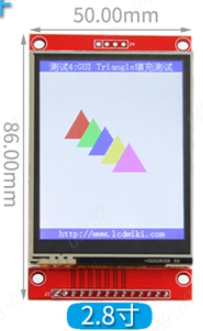
Data Download Link:http://www.lcdwiki.com/en/2.8inch_SPI_Module_ILI9341_SKU:MSP2807
2Specifications>>>
Download the data from the link above.
Operating Voltage:3.3V-5V
Operating Current:90mA
Module Size:50.0(H) x 86(V) MM
Pixel Size:320(H) x 240(V) RGB
Driver Chip:ILI9341
Communication Protocol:SPI
Operating Current:90mA
Module Size:50.0(H) x 86(V) MM
Pixel Size:320(H) x 240(V) RGB
Driver Chip:ILI9341
Communication Protocol:SPI
3Porting Process>>>
Our goal is to port the example to the Lichuang CW32F030C8T6 development board. Follow the steps below to complete the porting.
- Import the source code into the project;
- Make rough modifications based on compilation errors;
- Modify pin configurations;
- Modify timing configurations;
- Porting verification.
3.1View Data
Open the manufacturer’s example data (example download can be found in the example download). The specific path is shown in the figure below.
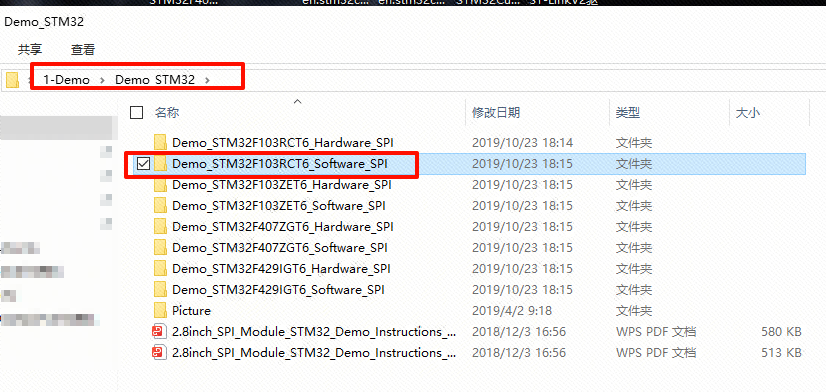 3.2Porting to the ProjectCopy the folders 【LCD】, 【SPI】, 【TOUCH】 from the manufacturer’s data path and the GUI.c, GUI.h, test.c, and test.h files from the User folder into your own project. Your project must have at least a millisecond-level delay function. (You can refer to the blank project for download)
3.2Porting to the ProjectCopy the folders 【LCD】, 【SPI】, 【TOUCH】 from the manufacturer’s data path and the GUI.c, GUI.h, test.c, and test.h files from the User folder into your own project. Your project must have at least a millisecond-level delay function. (You can refer to the blank project for download)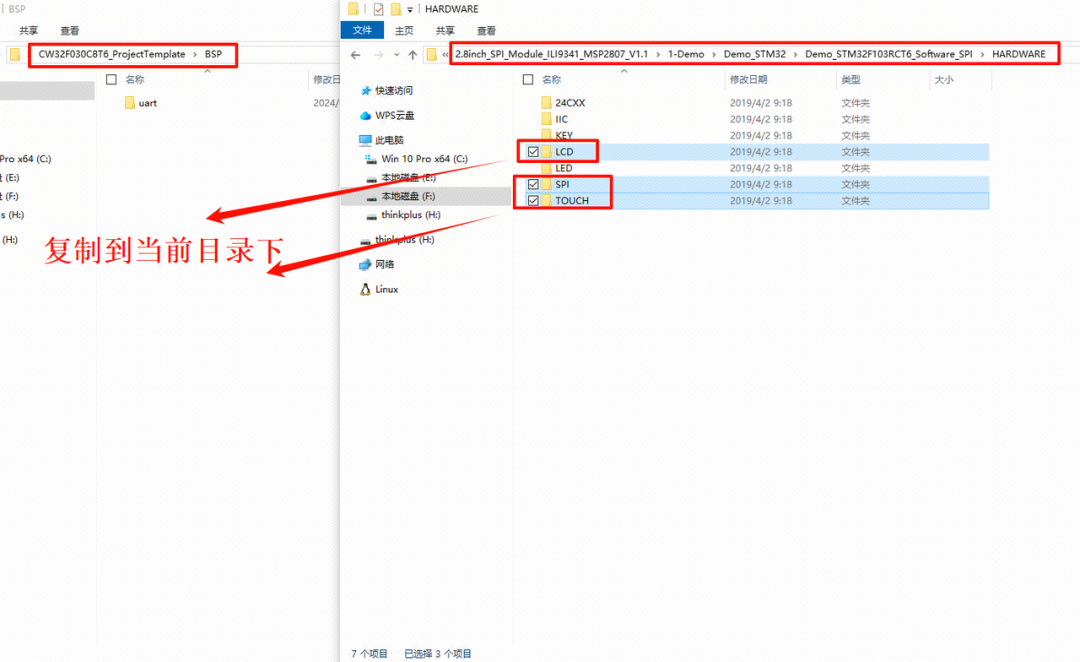
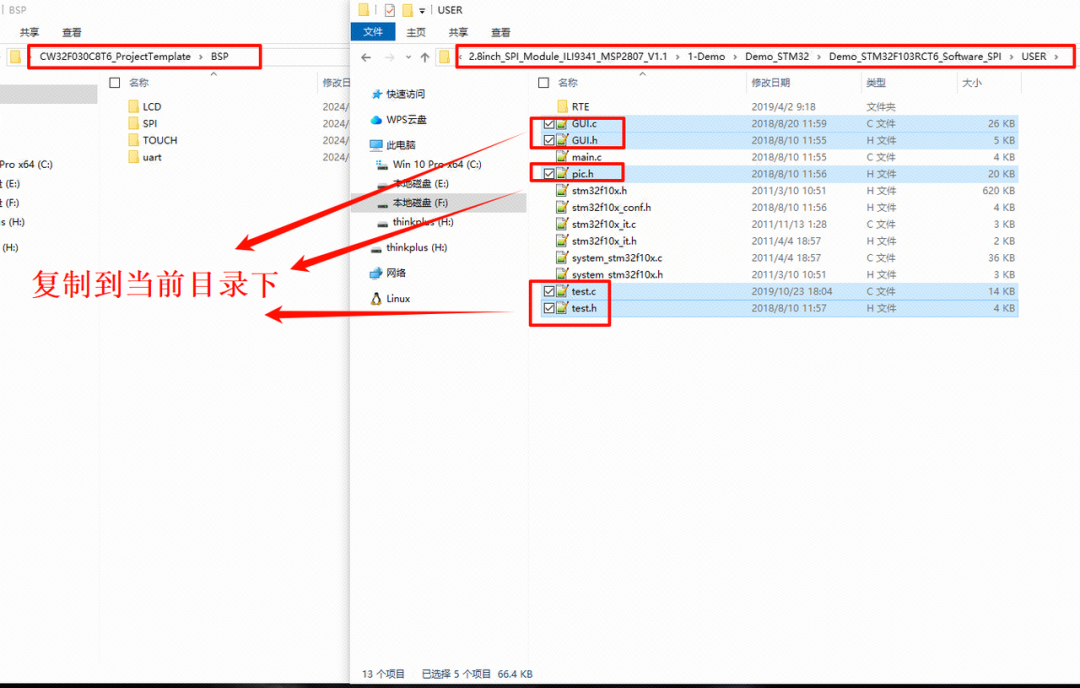
Open your project and import the .c and .h files that we just copied.
https://wiki.lckfb.com/en/dwx-cw32f030c8t6/module/screen/2-8-and-3-2-ili9341-color-screen.html (Click to view the original text with animations)
Define three macros, s32, u16, and u8 in touch.h, spi.h, gui.h, and test.h files.
Replace #include “sys.h” with #include “board.h”
#include "board.h"
#ifndef u8
#define u8 uint8_t
#endif
#ifndef u16
#define u16 uint16_t
#endif
#ifndef s32
#define s32 uint32_t
#endif
#ifndef u32
#define u32 uint32_t
#endifComment out the header file delay.h in touch.c, lcd.c, GUI.c, and test.c files!!
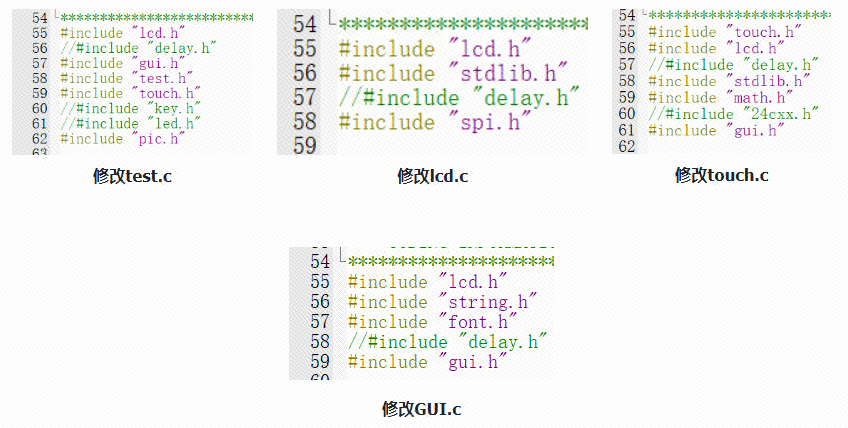 3.3Pin SelectionThe screen requires 14 interface settings, specific interface descriptions can be found in the manufacturer’s data screen specification. The current manufacturer’s source code uses a software SPI interface, and the SPI timing part has been completed by the manufacturer, so we only need to configure the hardware SPI pin timing and delays. Therefore, please connect the screen pins according to your needs. The selected pins are shown in the screen wiring.
3.3Pin SelectionThe screen requires 14 interface settings, specific interface descriptions can be found in the manufacturer’s data screen specification. The current manufacturer’s source code uses a software SPI interface, and the SPI timing part has been completed by the manufacturer, so we only need to configure the hardware SPI pin timing and delays. Therefore, please connect the screen pins according to your needs. The selected pins are shown in the screen wiring.
After selecting the pins, enter the project and start writing the screen pin initialization code.
3.4Port ModificationFor convenience in future porting, I defined each pin in lcd.h, which can be modified as needed.
//-----------------LCD Port Porting----------------
#define RCC_LCD1_ENABLE() __RCC_GPIOA_CLK_ENABLE()
#define RCC_LCD2_ENABLE() __RCC_GPIOB_CLK_ENABLE()
//SCK
#define PORT_LCD_SCL CW_GPIOA
#define GPIO_LCD_SCL GPIO_PIN_6
//MOSI
#define PORT_LCD_SDA CW_GPIOA
#define GPIO_LCD_SDA GPIO_PIN_7
//MIS0
//#define PORT_LCD_MIS GPIOB
//#define GPIO_LCD_MIS GPIO_PIN_14
//NSS
#define PORT_LCD_CS CW_GPIOB
#define GPIO_LCD_CS GPIO_PIN_10
//DC
#define PORT_LCD_DC CW_GPIOB
#define GPIO_LCD_DC GPIO_PIN_0
//RES
#define PORT_LCD_RES CW_GPIOB
#define GPIO_LCD_RES GPIO_PIN_1
//BLK/LED
#define PORT_LCD_BLK CW_GPIOA
#define GPIO_LCD_BLK GPIO_PIN_5
//CS2/T_CS
#define PORT_LCD_CS2 CW_GPIOA
#define GPIO_LCD_CS2 GPIO_PIN_3
//PEN/T_IRQ
#define PORT_LCD_PEN CW_GPIOA
#define GPIO_LCD_PEN GPIO_PIN_0
//T_CLK
#define PORT_LCD_TCLK CW_GPIOA
#define GPIO_LCD_TCLK GPIO_PIN_4
//T_DIN
#define PORT_LCD_TDIN CW_GPIOA
#define GPIO_LCD_TDIN GPIO_PIN_2
//T_DO
#define PORT_LCD_TD0 CW_GPIOA
#define GPIO_LCD_TD0 GPIO_PIN_1Modify the void LCD_GPIOInit(void) function in the lcd.c source code to the following code.
The code has already adapted the SPI pins. If you have not modified the related pins, set the macro definition USE_HARDWARE_SPI to 1.
void LCD_GPIOInit(void){
GPIO_InitTypeDef GPIO_InitStruct; // GPIO initialization structure
RCC_LCD1_ENABLE(); // Enable GPIO clock
RCC_LCD2_ENABLE(); // Enable GPIO clock
GPIO_InitStruct.Pins = GPIO_LCD_SCL| // GPIO pins
GPIO_LCD_SDA|
GPIO_LCD_BLK;
GPIO_InitStruct.Mode = GPIO_MODE_OUTPUT_PP; // Push-pull output
GPIO_InitStruct.Speed = GPIO_SPEED_HIGH; // High output speed
GPIO_Init(PORT_LCD_SCL, &GPIO_InitStruct); // Initialize
GPIO_InitStruct.Pins = GPIO_LCD_DC|
GPIO_LCD_RES|
GPIO_LCD_CS;
GPIO_Init(PORT_LCD_CS, &GPIO_InitStruct); // Initialize
}Modify the LCD Port Definition macro in lcd.h to:
//////////////////////////////////////////////////////////////////////-----------------LCD Port Definition----------------
// LCD control pin set to 1 operation statement macro definition
#define LCD_CS_SET GPIO_WritePin(PORT_LCD_CS, GPIO_LCD_CS, GPIO_Pin_SET)
#define LCD_RS_SET GPIO_WritePin(PORT_LCD_DC, GPIO_LCD_DC, GPIO_Pin_SET)
#define LCD_SDA_SET GPIO_WritePin(PORT_LCD_SDA, GPIO_LCD_SDA, GPIO_Pin_SET)
#define LCD_SCL_SET GPIO_WritePin(PORT_LCD_SCL, GPIO_LCD_SCL, GPIO_Pin_SET)
#define LCD_RST_SET GPIO_WritePin(PORT_LCD_RES, GPIO_LCD_RES, GPIO_Pin_SET)
#define LCD_LED_SET GPIO_WritePin(PORT_LCD_BLK, GPIO_LCD_BLK, GPIO_Pin_SET)
// LCD control pin set to 0 operation statement macro definition
#define LCD_CS_CLR GPIO_WritePin(PORT_LCD_CS, GPIO_LCD_CS, GPIO_Pin_RESET)
//CS
#define LCD_RS_CLR GPIO_WritePin(PORT_LCD_DC, GPIO_LCD_DC, GPIO_Pin_RESET)
//DC
#define LCD_SDA_CLR GPIO_WritePin(PORT_LCD_SDA, GPIO_LCD_SDA, GPIO_Pin_RESET)
//SDA=MOSI
#define LCD_SCL_CLR GPIO_WritePin(PORT_LCD_SCL, GPIO_LCD_SCL, GPIO_Pin_RESET)
//SCL=SCLK
#define LCD_RST_CLR GPIO_WritePin(PORT_LCD_RES, GPIO_LCD_RES, GPIO_Pin_RESET)
//RES
#define LCD_LED_CLR GPIO_WritePin(PORT_LCD_BLK, GPIO_LCD_BLK, GPIO_Pin_RESET)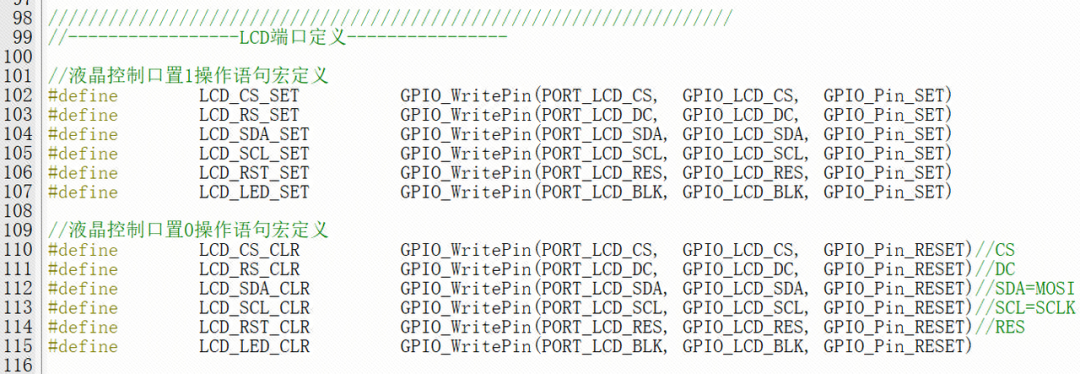
3.5Driver ModificationIn the SPI.c file, find the void SPIv_WriteData(unsigned char Data) function and modify it as follows.
void SPIv_WriteData(u8 Data){
unsigned char i=0;
for(i=8;i>0;i--)
{
if(Data&0x80)
LCD_SDA_SET; // Output data
else
LCD_SDA_CLR;
LCD_SCL_CLR;
LCD_SCL_SET;
Data<<=1;
}
}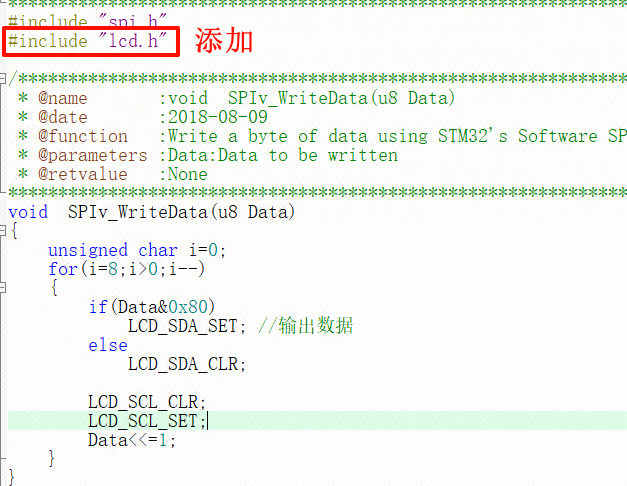
In spi.h, the manufacturer defined macros for the SPI interface, here we will comment them out and use our own method.

Open the touch.c file and modify the following content:
- Modify the u8 TP_Init(void) function;
u8 TP_Init(void){
GPIO_InitTypeDef GPIO_InitStructure;
/* PEN */
GPIO_InitStructure.Pins = GPIO_LCD_PEN;
GPIO_InitStructure.Mode = GPIO_MODE_INPUT_PULLUP; // Pull-up input
GPIO_InitStructure.Speed = GPIO_SPEED_HIGH;
GPIO_Init(PORT_LCD_PEN, &GPIO_InitStructure);
/* DOUT*/
GPIO_InitStructure.Pins = GPIO_LCD_TD0;
GPIO_InitStructure.Mode = GPIO_MODE_INPUT_PULLUP; // Pull-up input
GPIO_InitStructure.Speed = GPIO_SPEED_HIGH;
GPIO_Init(PORT_LCD_TD0, &GPIO_InitStructure);
/* TDIN*/
GPIO_InitStructure.Pins = GPIO_LCD_TDIN;
GPIO_InitStructure.Mode = GPIO_MODE_OUTPUT_PP;// Push-pull output mode
GPIO_InitStructure.Speed = GPIO_SPEED_HIGH;
GPIO_Init(PORT_LCD_TDIN, &GPIO_InitStructure);
/* TCLK*/
GPIO_InitStructure.Pins = GPIO_LCD_TCLK;
GPIO_InitStructure.Mode = GPIO_MODE_OUTPUT_PP;// Push-pull output mode
GPIO_InitStructure.Speed = GPIO_SPEED_HIGH;
GPIO_Init(PORT_LCD_TCLK, &GPIO_InitStructure);
/* TCS*/
GPIO_InitStructure.Pins = GPIO_LCD_CS2;
GPIO_InitStructure.Mode = GPIO_MODE_OUTPUT_PP;// Push-pull output mode
GPIO_InitStructure.Speed = GPIO_SPEED_HIGH;
GPIO_Init(PORT_LCD_CS2, &GPIO_InitStructure);
TP_Read_XY(&tp_dev.x,&tp_dev.y);// First read initialization
return 1;
}2. Comment out the void TP_Save_Adjdata(void) and u8 TP_Get_Adjdata(void) functions.
3. Find the void TP_Adjust(void) function and comment out TP_Save_Adjdata(); and TP_Get_Adjdata(); inside the function.
4. Open the test.c file and make some modifications: find the void Touch_Test(void); function, comment out some statements inside, and change the key==1 in line 282 to 1.5. Open the lcd.c file and find the void LCD_Init(void); function, replace LCD_LED=1; with LCD_LED_SET;6. Open the touch.h file and change part of the code to the following:
#define PEN GPIO_ReadPin(PORT_LCD_PEN,GPIO_LCD_PEN) //INT
#define DOUT GPIO_ReadPin(PORT_LCD_TD0,GPIO_LCD_TD0) //MISO
#define TDIN(x) GPIO_WritePin(PORT_LCD_TDIN,GPIO_LCD_TDIN,x?GPIO_Pin_SET:GPIO_Pin_RESET) //MOSI
#define TCLK(x) GPIO_WritePin(PORT_LCD_TCLK,GPIO_LCD_TCLK,x?GPIO_Pin_SET:GPIO_Pin_RESET) //SCLK
#define TCS(x) GPIO_WritePin(PORT_LCD_CS2, GPIO_LCD_CS2, x?GPIO_Pin_SET:GPIO_Pin_RESET) //CS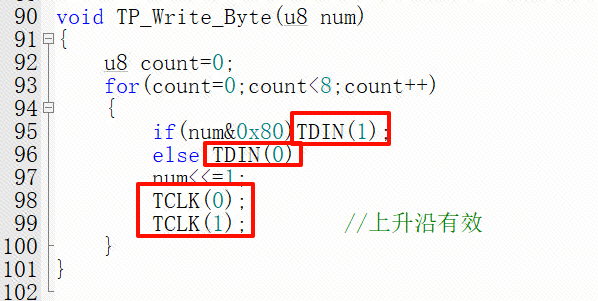
- Then we open the touch.c file and replace the following forms of statements with the following:
TCLK = 1; -----replace with------> TCLK(1);
TCLK = 0; -----replace with------> TCLK(0);
TDIN = 1; -----replace with------> TDIN(1);
TDIN = 0; -----replace with------> TDIN(0);
TCS = 1; -----replace with------> TCS(1);
TCS = 0; -----replace with------> TCS(0);
For example:

At this point, the porting is complete. Please proceed to section 4 for porting verification.
4Porting Verification>>>Enter the following code in main.c
/* * Change Logs: * Date Author Notes * 2024-06-18 LCKFB-LP first version */
#include "board.h"
#include "stdio.h"
#include "bsp_uart.h"
#include "lcd.h"
#include "gui.h"
#include "test.h"
int32_t main(void){
board_init(); // Development board initialization
uart1_init(115200); // Serial port 1 baud rate 115200
LCD_Init(); // LCD screen initialization
while(1)
{
main_test(); // Test main interface
Test_Color(); // Simple screen fill test
Test_FillRec(); // GUI rectangle drawing test
Test_Circle(); // GUI circle drawing test
Test_Triangle(); // GUI triangle drawing test
English_Font_test(); // English font example test
Chinese_Font_test(); // Chinese font example test
Pic_test(); // Image display example test
Rotate_Test(); // Rotation display test
/* If not using touch, or do not need touch functionality, please comment out the following touch screen test item */
Touch_Test(); // Touch screen handwriting test
}
}Porting Phenomenon:
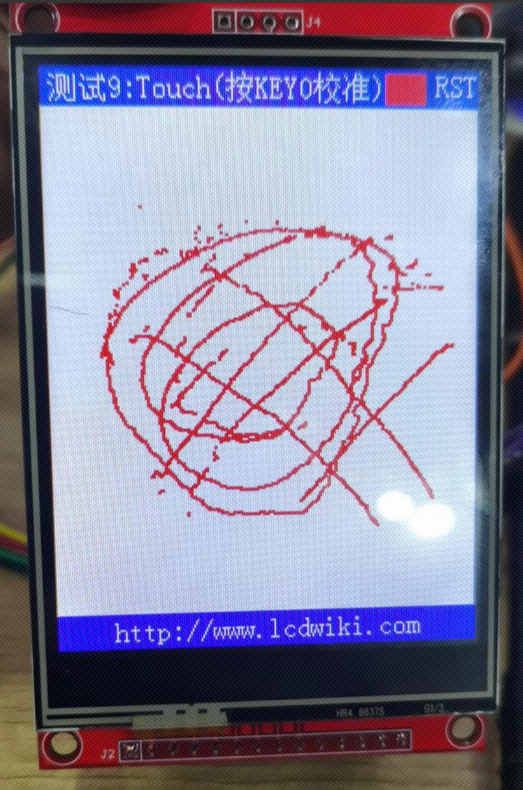
Successful Porting Example Code:
Link:https://pan.baidu.com/s/1pu5PsMlW1PlWOAGTy-iBuw?pwd=LCKF
Extraction Code: LCKF
ENDPrevious ReviewsREVIEW
【Product Application】CW32 Electric Tool Product Open Source
【Product Solution】Low-cost Electric Tool Solution Based on CW32L010
【Product Application】Smart Power Bank Based on CW32 (Open Source Solution)
【Product Application】CW-W88 General Control Board Design Scheme (Open Source)
【Product Application】Controller Product Scheme Based on CW32 for Angle Grinder
【Product Solution】Low Voltage Brushless Fan Sensorless Controller Based on CW32F030C8
【Product Solution】Brushless DC Hollow Cup Motor Sensor Control Drive Scheme Based on CW32
【Product Solution】Brushless DC Hollow Cup Motor Sensorless Square Wave Control Drive Scheme Based on CW32
【Product Solution】Digital Voltage and Current Meter Product Scheme Based on CW32F003E4P7
【Product Solution】Low-cost Industrial Instrument Based on CW32L010
CW32 Ecological Community (WX) Group
 Scan to Join QQ Group4 Group | 478586307
Scan to Join QQ Group4 Group | 478586307
Get materials and“Developer Support Program”First-hand information
